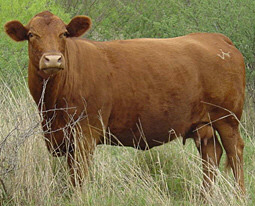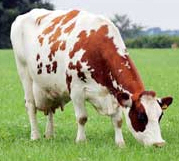



Santa Cruz
History
In 1987, the need for a more market acceptable beef animal at King Ranch, Texas, was the topic of conversation from the working pens to the board room. Top producers in the beef and livestock industry were brought in to aid in the project. Educators from the major agricultural universities across the United States were invited to share their knowledge with King Ranch. Photo courtesy of King Ranch Inc., www.king-ranch.com |
As a result of these meetings, King Ranch set some short and long term objectives in its breeding plan. Short term objectives included improved production (reproduction and fertility); improved market acceptability (carcass quality - grade and tenderness); and, cull cattle on strict economic considerations. Long term objectives included single breed type mating system using a composite breed; genetic policy that would produce a phenotypic look-alike; and, early sexual maturity with superior carcass quality and grade. The Santa Gertrudis breed was maintained, improved, and made more competitive.
Two breeds were selected to add to the Santa Gertrudis to achieve these goals. Gelbvieh were chosen for their fertility, high growth, early maturity, shortened gestation length, and moderate milk production. Red Angus were selected to add early fertility, ease in calving, high carcass quality, efficiency, and polled characteristics.
The new cattle are a composite breed, produced by first crossing Santa Gertrudis cows with Red Angus and Gelbvieh bulls. This initial union produces 1/2 Santa Gertrudis and 1/2 Red Angus males and females; as well as 1/2 Santa Gertrudis and 1/2 Gelbvieh males and females. These half bloods are then crossed back on each other to produce a 1/2 Santa Gertrudis, 1/4 Red Angus and 1/4 Gelbvieh composite animal, the finished product. This is King Ranch Santa Cruz, as composites are then bred to composites, fixing the characteristics desired in the cattle and demanded by today's beef market.
Characteristics
The Santa Cruz can be either polled or horned. In colour, they range from a light red or honey to a Santa Gertrudis cherry red. Mature weight in cows ranges from 1100-1200 pounds, while bulls tip the scales from 1800-2000 pounds.The cattle have proven very heat resistant and adapt extremely well to South Texas' harsh climate and environments.
Both females and males reach an early sexual maturity at 12-14 months of age, the females have good mothering instincts.
Statistics
Comparative
Distribution
Santa Cruz cattle are produced in the USA.References (the above information was cited from the following sites)
www.king-ranch.com


